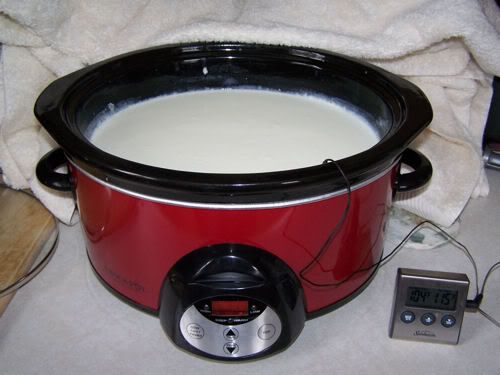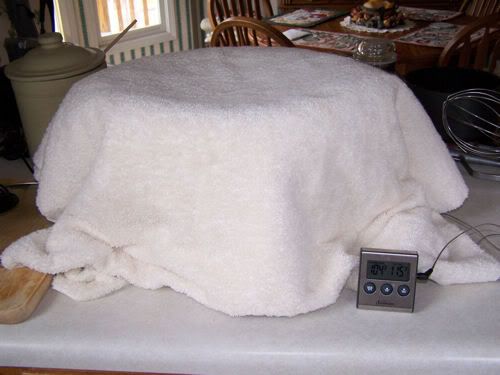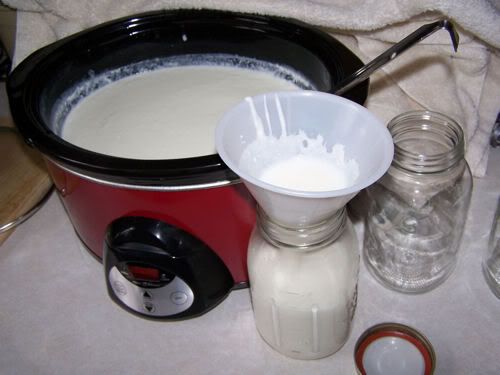We are living in a world today where lemonade is made from artificial flavors and furniture polish is made from real lemons. ~Alfred E. Newman
You may be thinking I went off to my "happy place" and forgot about my blog, right? Actually, I am holding off my own answer to my previous post for now. In the meantime, both my favorite aunt (okay, she is my only aunt but I am sure she would be my favorite if I had others) and a friend dear to me asked for me to write it out my secrets for making yogurt in a slow cooker on my blog so here it is.
I just started making yogurt in recent months, which I wrote about previously here. Before my experimentation with yogurt, I would make clabbered milk, which is far less fussing. I think I now have a method of making yogurt for reliable results, at least for me in my own kitchen. The first thing is I use raw milk, because that is the only type I have been buying for last twenty years. However, since the milk must be heated to at least 180°F, just about any kind of milk can be used: whole, low fat, non-fat, even powdered. It also can be pasteurized or not, since you are going to be heating it anyway.
It seems counterproductive to heat raw milk, but if it is not heated to kill back most of the natural cultures, these will be in competition with the desired yogurt cultures when they are added back, so this is not the way to make raw milk yogurt—I am still working on that one. I have made raw milk yogurt a few times, only heating to between 110°-120°F, and the results are not the same consistency as the yogurt bought in stores, something between clabbered milk and yogurt in taste, but it seems a bit thinner than clabbered milk to me. Also, it is less predictable, I think; I had a few batches that separated into something like a soft cheese and whey, which was an edible addition to our salad. The rule with raw milk is that it is always in an edible state, unless contaminated with harmful bacteria, that is. So, if you are of the mind to experiment and share your method, I would be interested.
I pour in one gallon of milk into a six-quart slow cooker with a removable crock. (You can use less milk if you are making a smaller batch.) I set my slow cooker on high and place the probe of a digital cooking thermometer into the milk. Although the milk needs only to be heated to 180°F, the last time I made it I heated it to 185°F and the yogurt came out much thicker than usual, however that could have been due to other factors also. Yogurt making, I have found, is much like sourdough bread making: it is an art and much depends on humidity and other factors within and beyond my control.
One thing I believe works in favor of a thicker yogurt is not using a lid on the slow cooker; I wrap the slow cooker in two heavy bath towels instead. This not only speeds up the heating process, but allows the moisture to escape. Some people suggest venting the lid by using chopsticks, but I have two reasons for not doing this: one, my lid is oval and would not be stable enough, and two, I always see condensation on the inside of the lid, which may be a factor in thickness.
After the milk has been heated to the desired temperature, I usually like it to cool as quickly as possible. I turn off the slow cooker, remove the heavy towels, and immediately remove the crock, placing it on a rack. I place a lighter dish towel over the top to cover it. If it has not already, a skin will develop on the top, which is normal.
When it gets down to under 120°F, I add fresh yogurt, specifically Stonyfield Organic Yogurt, to the milk, although any well-cultured yogurt will do. You can add yogurt from a previous batch, but I have not done this personally as I have read that after two batches fresh cultures should be introduced anyway. (Maybe that is not really necessary? Something to experiment with later on perhaps.) I really don't measure the amount of my yogurt starter, but I probably add between ¼ to ½ cup. I whisk it in, which also breaks up the skin on top. Then I place the crock back into the slow cooker, wrap it up with the two heavy bath towels, and turn it to the "keep warm" setting for a few minutes. This is just because I noticed it cools a few more degrees if the slow cooker is not warm. The temperature of the milk should be between 110°F and 120°F, although I usually like it heated no higher than 110°F because the temperature will continue to rise after I have turned the slow cooker off and 115°F is the highest temperature I prefer. If it gets over 120°F, you can allow it to cool and add more yogurt, but if the temperature goes over 130°F the consistency may not be as smooth regardless—yes, this happened to me once or twice as the beeper is not very loud on my digital thermometer.
You can leave it all wrapped up and turned off overnight. In the morning, the temperature is usually around 90°-95°F for me. If you are making it during the day, you might check the temperature and turn on the slow cooker for a few minutes until it again reaches 110°F. If it is not as thick as you would like, you can continue this process for a few more hours. I have had some batches that were done in just eight hours and others took nearly 24 hours. Again, making yogurt is an art and you can leave it for hours if you must.
If you just cannot seem to get it as thick as you would like, you can add one to four tablespoons of powdered milk and whisk well or use a hand mixer. This is best done when adding the starter, but it can be done at any time and then give it a few hours for the cultures to...uh, cultivate, I guess would be the term.
To finish up, I use a ladle and a funnel to fill up four one-quart canning jars, while the yogurt is still warm. This results in a good seal when placed in the refrigerator. Yogurt lasts weeks that way.
I use yogurt in cooking quite a bit, but the reason that gallon of yogurt only lasts about ten days or less most times is my daughter and I have yogurt and granola with fruit nearly every morning for breakfast. Speaking about granola, I have not seen my favorite granola on sale for sometime and we were nearly out of stock at home so...just this week, I made my first batch of granola also in my slow cooker! It tasted good, but just not quite as flavorful nor did it have the cluster consistency I would like so you will have to wait until I have perfected my granola technique before you will see a post on it here.
I just started making yogurt in recent months, which I wrote about previously here. Before my experimentation with yogurt, I would make clabbered milk, which is far less fussing. I think I now have a method of making yogurt for reliable results, at least for me in my own kitchen. The first thing is I use raw milk, because that is the only type I have been buying for last twenty years. However, since the milk must be heated to at least 180°F, just about any kind of milk can be used: whole, low fat, non-fat, even powdered. It also can be pasteurized or not, since you are going to be heating it anyway.
It seems counterproductive to heat raw milk, but if it is not heated to kill back most of the natural cultures, these will be in competition with the desired yogurt cultures when they are added back, so this is not the way to make raw milk yogurt—I am still working on that one. I have made raw milk yogurt a few times, only heating to between 110°-120°F, and the results are not the same consistency as the yogurt bought in stores, something between clabbered milk and yogurt in taste, but it seems a bit thinner than clabbered milk to me. Also, it is less predictable, I think; I had a few batches that separated into something like a soft cheese and whey, which was an edible addition to our salad. The rule with raw milk is that it is always in an edible state, unless contaminated with harmful bacteria, that is. So, if you are of the mind to experiment and share your method, I would be interested.
I pour in one gallon of milk into a six-quart slow cooker with a removable crock. (You can use less milk if you are making a smaller batch.) I set my slow cooker on high and place the probe of a digital cooking thermometer into the milk. Although the milk needs only to be heated to 180°F, the last time I made it I heated it to 185°F and the yogurt came out much thicker than usual, however that could have been due to other factors also. Yogurt making, I have found, is much like sourdough bread making: it is an art and much depends on humidity and other factors within and beyond my control.
One thing I believe works in favor of a thicker yogurt is not using a lid on the slow cooker; I wrap the slow cooker in two heavy bath towels instead. This not only speeds up the heating process, but allows the moisture to escape. Some people suggest venting the lid by using chopsticks, but I have two reasons for not doing this: one, my lid is oval and would not be stable enough, and two, I always see condensation on the inside of the lid, which may be a factor in thickness.
After the milk has been heated to the desired temperature, I usually like it to cool as quickly as possible. I turn off the slow cooker, remove the heavy towels, and immediately remove the crock, placing it on a rack. I place a lighter dish towel over the top to cover it. If it has not already, a skin will develop on the top, which is normal.
When it gets down to under 120°F, I add fresh yogurt, specifically Stonyfield Organic Yogurt, to the milk, although any well-cultured yogurt will do. You can add yogurt from a previous batch, but I have not done this personally as I have read that after two batches fresh cultures should be introduced anyway. (Maybe that is not really necessary? Something to experiment with later on perhaps.) I really don't measure the amount of my yogurt starter, but I probably add between ¼ to ½ cup. I whisk it in, which also breaks up the skin on top. Then I place the crock back into the slow cooker, wrap it up with the two heavy bath towels, and turn it to the "keep warm" setting for a few minutes. This is just because I noticed it cools a few more degrees if the slow cooker is not warm. The temperature of the milk should be between 110°F and 120°F, although I usually like it heated no higher than 110°F because the temperature will continue to rise after I have turned the slow cooker off and 115°F is the highest temperature I prefer. If it gets over 120°F, you can allow it to cool and add more yogurt, but if the temperature goes over 130°F the consistency may not be as smooth regardless—yes, this happened to me once or twice as the beeper is not very loud on my digital thermometer.
You can leave it all wrapped up and turned off overnight. In the morning, the temperature is usually around 90°-95°F for me. If you are making it during the day, you might check the temperature and turn on the slow cooker for a few minutes until it again reaches 110°F. If it is not as thick as you would like, you can continue this process for a few more hours. I have had some batches that were done in just eight hours and others took nearly 24 hours. Again, making yogurt is an art and you can leave it for hours if you must.
If you just cannot seem to get it as thick as you would like, you can add one to four tablespoons of powdered milk and whisk well or use a hand mixer. This is best done when adding the starter, but it can be done at any time and then give it a few hours for the cultures to...uh, cultivate, I guess would be the term.
To finish up, I use a ladle and a funnel to fill up four one-quart canning jars, while the yogurt is still warm. This results in a good seal when placed in the refrigerator. Yogurt lasts weeks that way.
I use yogurt in cooking quite a bit, but the reason that gallon of yogurt only lasts about ten days or less most times is my daughter and I have yogurt and granola with fruit nearly every morning for breakfast. Speaking about granola, I have not seen my favorite granola on sale for sometime and we were nearly out of stock at home so...just this week, I made my first batch of granola also in my slow cooker! It tasted good, but just not quite as flavorful nor did it have the cluster consistency I would like so you will have to wait until I have perfected my granola technique before you will see a post on it here.
~ I am reminded, my Lord, that like yogurt, we have to be cultivated often according to conditions unique to each of us, that for me to become as You wish for me to be is no less due to Your patience and skill, my Master. ~



